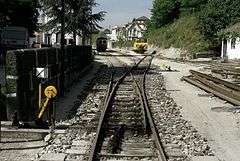Tâmega line



The Tâmega line (Linha do Tâmega) was a metre gauge railway line in northern Portugal. It closely followed the course of the Tâmega River. It closed in 2009.
History
The southern part of the line opened in 1909; it ran between Livração (the junction with the main Douro line) and Amarante in the District of Oporto, near the River Tâmega. The line was eventually opened as far north as Arco de Baúlhe in 1949, the last such extension to Portugal's narrow gauge railway network. Livração station was a junction with the main Douro Valley railway line; it is still served by CP's 1668mm gauge trains to and from Oporto.[1]
| Construction of section | Distance | Opened |
|---|---|---|
| Livração – Amarante | 12.77 km | 21 March 1909 |
| Amarante - Chapa | 8.43 km | 22 Nov 1926 |
| Chapa - Celorico de Basto | 13.37 km | 20 March 1932 |
| Celorico de Basto - Arco de Baúlhe | 17.16 km | 15 Jan 1949 |
Train services were operated by Comboios de Portugal (CP); the three Série 9100 diesel railcars were built in 1949 by the Swedish company NOHAB specifically for use on the Tâmega line. They continued in service until 2002 (when replaced by Série 9500 units, purchased secondhand from Yugoslavia). CP Série 9020 diesel locomotives were also used on the line.
Closure
The northern section of the line, between Amarante and Arco de Baúlhe, closed in 1990. Arco de Baúlhe station was served by trains for little over 40 years.
The remaining part of the line south of Amarante closed in 2009 - ostensibly due to the need for urgent repair work. The Strategic Transport Plan, published by the Portuguese Government in October 2011, showed that the Tâmega line required the highest level of subsidy (at €2.50 per passenger per kilometre) of any railway in Portugal and thus the line was listed for permanent closure.[2] On 1 January 2012 the replacement bus service was also withdrawn.[3] The construction of the A4 motorway, which reached Amarante in 1995, effectively made the railway line unviable and unessential as a mode of transport.
Other narrow gauge railways in the Douro Valley
- Corgo line - closed 2009
- Sabor line - closed 1988
- Tua line - closed 2008
References
- ↑ Portugal Narrow Gauge by J. Organ, Middleton Press, 2010, ISBN 978 1 906008 67 3
- ↑ The Portuguese Government's Strategic Transport Plan for 2011-2015 (in Portuguese)
- ↑ CP press release confirming the closure of the line